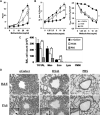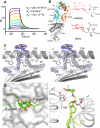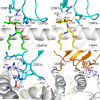Structural and functional characterization of a novel nonglycosidic type I NKT agonist with immunomodulatory properties
- PMID: 22301545
- PMCID: PMC3288653
- DOI: 10.4049/jimmunol.1103049
Structural and functional characterization of a novel nonglycosidic type I NKT agonist with immunomodulatory properties
Erratum in
- J Immunol. 2012 Oct 15;189(8):4194. Alari-Pahisa, Elisenda [corrected to Alari-Pahissa, Elisenda]
Abstract
Activation of type I NKT (iNKT) cells by CD1d-presented agonists is a potent immunotherapeutic tool. α-Galactosylceramide (α-GalCer) is the prototypic agonist, but its excessive potency with simultaneous production of both pro- and anti-inflammatory cytokines hampers its potential therapeutic use. In search for novel agonists, we have analyzed the structure and function of HS44, a synthetic aminocyclitolic ceramide analog designed to avoid unrestrained iNKT cell activation. HS44 is a weaker agonist compared with α-GalCer in vitro, although in vivo it induces robust IFN-γ production, and highly reduced but still functional Th2 response. The characteristic cytokine storm produced upon α-GalCer activation was not induced. Consequently, HS44 induced a very efficient iNKT cell-dependent antitumoral response in B16 animal model. In addition, intranasal administration showed the capacity to induce lung inflammation and airway hyperreactivity, a cardinal asthma feature. Thus, HS44 is able to elicit functional Th1 or Th2 responses. Structural studies show that HS44 binds to CD1d with the same conformation as α-GalCer. The TCR binds to HS44 similarly as α-GalCer, but forms less contacts, thus explaining its weaker TCR affinity and, consequently, its weaker recognition by iNKT cells. The ability of this compound to activate an efficient, but not massive, tailored functional immune response makes it an attractive reagent for immune manipulation.
Figures







Similar articles
-
Amide analogues of CD1d agonists modulate iNKT-cell-mediated cytokine production.ACS Chem Biol. 2012 May 18;7(5):847-55. doi: 10.1021/cb2005017. Epub 2012 Feb 29. ACS Chem Biol. 2012. PMID: 22324848 Free PMC article.
-
α-Galactosylceramide treatment before allergen sensitization promotes iNKT cell-mediated induction of Treg cells, preventing Th2 cell responses in murine asthma.J Biol Chem. 2019 Apr 5;294(14):5438-5455. doi: 10.1074/jbc.RA118.005418. Epub 2019 Feb 11. J Biol Chem. 2019. PMID: 30745361 Free PMC article.
-
Activation of human invariant natural killer T cells with a thioglycoside analogue of α-galactosylceramide.Clin Immunol. 2011 Aug;140(2):196-207. doi: 10.1016/j.clim.2011.03.016. Epub 2011 Apr 13. Clin Immunol. 2011. PMID: 21493160
-
Tailored design of NKT-stimulatory glycolipids for polarization of immune responses.J Biomed Sci. 2017 Mar 23;24(1):22. doi: 10.1186/s12929-017-0325-0. J Biomed Sci. 2017. PMID: 28335781 Free PMC article. Review.
-
Switching invariant natural killer T (iNKT) cell response from anticancerous to anti-inflammatory effect: molecular bases.J Med Chem. 2014 Jul 10;57(13):5489-508. doi: 10.1021/jm4010863. Epub 2014 Feb 12. J Med Chem. 2014. PMID: 24428717 Review.
Cited by
-
Turned on by danger: activation of CD1d-restricted invariant natural killer T cells.Immunology. 2012 Sep;137(1):20-7. doi: 10.1111/j.1365-2567.2012.03612.x. Immunology. 2012. PMID: 22734667 Free PMC article. Review.
-
Invariant NKT cells: regulation and function during viral infection.PLoS Pathog. 2012;8(8):e1002838. doi: 10.1371/journal.ppat.1002838. Epub 2012 Aug 16. PLoS Pathog. 2012. PMID: 22916008 Free PMC article. Review.
-
New Paradigm in NKT Cell Antigens: MCS-0208 (2-(Hydroxymethyl)phenylthio-phytoceramide) - an Aryl-Phytoceramide Compound with a Single Hydroxyl Group Stimulates NKT Cells.ChemMedChem. 2021 Aug 19;16(16):2491-2496. doi: 10.1002/cmdc.202000992. Epub 2021 Jun 17. ChemMedChem. 2021. PMID: 33821540 Free PMC article.
-
Non-glycosidic compounds can stimulate both human and mouse iNKT cells.Eur J Immunol. 2016 May;46(5):1224-34. doi: 10.1002/eji.201546114. Epub 2016 Mar 1. Eur J Immunol. 2016. PMID: 26873393 Free PMC article.
-
Molecular basis of lipid antigen presentation by CD1d and recognition by natural killer T cells.Immunol Rev. 2012 Nov;250(1):167-79. doi: 10.1111/j.1600-065X.2012.01166.x. Immunol Rev. 2012. PMID: 23046129 Free PMC article. Review.
References
-
- Bendelac A, Savage PB, Teyton L. The biology of NKT cells. Annu Rev Immunol. 2007;25:297. - PubMed
-
- Zeng Z, Castano AR, Segelke BW, Stura EA, Peterson PA, Wilson IA. Crystal structure of mouse CD1: An MHC-like fold with a large hydrophobic binding groove. Science. 1997;277:339. - PubMed
-
- Zajonc DM, Kronenberg M. Carbohydrate specificity of the recognition of diverse glycolipids by natural killer T cells. Immunol Rev. 2009;230:188. - PubMed
-
- Zhou D, Mattner J, Cantu C, 3rd, Schrantz N, Yin N, Gao Y, Sagiv Y, Hudspeth K, Wu YP, Yamashita T, Teneberg S, Wang D, Proia RL, Levery SB, Savage PB, Teyton L, Bendelac A. Lysosomal glycosphingolipid recognition by NKT cells. Science. 2004;306:1786. - PubMed
Publication types
MeSH terms
Substances
Associated data
- Actions
Grants and funding
LinkOut - more resources
Full Text Sources
Other Literature Sources

